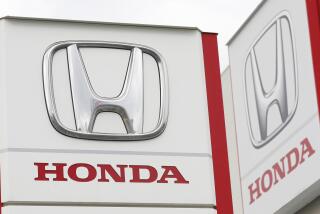New Leak Threatens Shuttle Test Firing
- Share via
CAPE CANAVERAL, Fla. — A new leak developed Sunday in Discovery’s fuel lines, halting the loading of fuel and raising the possibility of another postponement of a test firing of the space shuttle’s engines, NASA said.
The leak occurred as crews were filling the external fuel tanks with liquid hydrogen and oxygen, said Cindy Buck, spokeswoman for the National Aeronautics and Space Administration..
“We’re trouble-shooting the liquid hydrogen leak and looking to see if we will be able to continue filling the tank to completion right now,” she said early today.
Earlier Sunday, a two-part countdown resumed for the test-firing of Discovery’s engines after engineers repaired a hydrogen leak and a balky oxygen pump.
The problems that cropped up Friday had caused the fourth postponement in 10 days for the test, which is considered critical to certifying Discovery for the first shuttle flight since the Challenger disaster.
The leak and pump were repaired Saturday, and the test-firing is now scheduled to take place Thursday.
Officials believe the delays, combined with an unresolved leak in Discovery’s steering engine system, will slip the launch date from mid-September into October.
The leak and pump problems developed Friday soon after technicians began pouring more than half a million gallons of liquid hydrogen and liquid oxygen propellant into the spaceship’s external fuel tank on Launch Pad 39B.
It was the first attempt to fuel a space shuttle since Challenger exploded on Jan. 28, 1986, killing the crew of seven.
The exercise leading to the firing of the three main engines, with Discovery bolted firmly on the launch pad, is divided into two parts.
The first part involved fully fueling the tank and simulating a problem that forces a postponement with the countdown at 10 seconds before a mock liftoff. That was to take place today.
The launch team then was to empty the tank, restart the countdown, refill the tank and aim for a 20-second ignition of the engines at 7:30 a.m. Thursday.
The purpose of the overall test is to check several modifications made to the engines and launch pad since the Challenger accident.
More to Read
Sign up for Essential California
The most important California stories and recommendations in your inbox every morning.
You may occasionally receive promotional content from the Los Angeles Times.













